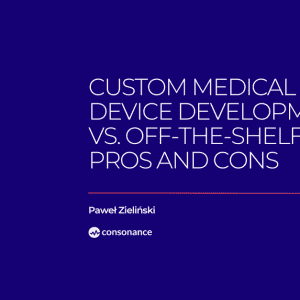10 Promising Neurology MedTech Startups in 2025

Today, more than 3 billion people worldwide are affected by neurological conditions, making them one of the leading causes of disease and disability globally. As the population continues to age, the number of individuals suffering from central nervous system disorders is expected to rise, driving increased demand for innovative medical technologies.
In recent years, a growing number of promising neurology MedTech startups have begun developing solutions at the intersection of neuroscience, artificial intelligence, biomedical engineering, and digital health. In this article, we highlight 10 bold startups who want to reshape the field of neurology and may soon revolutionize how we diagnose and treat conditions such as Alzheimer’s disease, epilepsy, and brain injuries.
10 Promising Neurology MedTech Startups
- Strolll
The solution offered by Strolll is an advanced Digital Therapeutics (DTx) platform that leverages Augmented Reality (AR) technology. The system utilizes AR smart glasses to display interactive visual stimuli directly in the patient’s field of vision. Strolll combines immersive technologies with evidence-based physiotherapy methods to enhance rehabilitation outcomes and improve patient adherence to therapy. The platform supports therapy delivery both under the supervision of a clinician (e.g., in a rehabilitation center) and in hybrid or fully remote settings.
- Inbrain Neuroelectronics
Inbrain Neuroelectronics is developing smart brain implants based on innovative graphene electrodes. These devices are designed to decode neural signals with high precision and deliver personalized therapeutic responses. The technology is being developed to treat neurological disorders such as epilepsy, Parkinson’s disease, and brain tumors.
- Amber Therapeutics
Amber Therapeutics is developing an advanced adaptive neuromodulation therapy for women with mixed urinary incontinence. The Picostim system is fully implantable and targets the pudendal nerve, offering both stimulation and real-time monitoring of physiological responses. Thanks to adaptive algorithms, the system dynamically responds to patient signals and personalizes the therapy accordingly.
- MintNeuro
MintNeuro is developing a new generation of neurological implants using compact semiconductor technology with low energy consumption. The company aims to offer minimally invasive procedures with the highest performance and medical quality. Its implantable systems enable monitoring, processing and modulation of neural activity, based on advanced, high performance integrated circuits designed for ultra low power consumption.
- BrainCapture
BrainCapture is developing mobile, low-cost EEG devices, AI assisted for diagnosing epilepsy in developing countries. The company aims to reduce the global gap in epilepsy treatment by offering technology that is easy to use even for non-medical personnel after a short training. Optimized for telemedicine, BrainCapture’s solution enable neurological diagnosis in regions with limited access to specialized healthcare.
- Newronika
Newronika is developing AlphaDBS, an implantable closed loop deep brain stimulation system. AlphaDBS detects local field potentials (LFP) in the stimulation target area and adapts the intensity of stimulation dynamically to optimize the patient’s clinical condition. Its proprietary FilterDBS technology enables artifact-free LFP recording even during active stimulation. The system integrates with a mobile app and the WebBioBank platform, paving the way for future development of advanced closed-loop algorithms.
- Reach Neuro
Reach Neuro is developing an innovative implantable electrode system for the cervical spinal cord, designed for stroke survivors. This technology aims to restore shoulder, arm, and hand function. The therapy is individually tailored to each patient, increasing its effectiveness and the likelihood of regaining mobility.
- Spire Therapeutics
Spire Therapeutics has developed a non-invasive device called Diadem that uses low-frequency, low-intensity ultrasound to precisely target deep brain structures through the skull and scalp. Obstructions, such as skull structure or hair, are identified and compensated for using two opposing arrays, allowing the ultrasound waves to be precisely focused. Therapy with the Diadem device can be used for people suffering from chronic pain or depression.
- Precisis
Easee is an innovative technology developed by Precisis that uses subcutaneous electrodes placed outside the skull. The device enables non-invasive neuromodulation therapy, representing a breakthrough in the treatment of epilepsy. By directing therapeutic currents to precisely targeted areas of the brain using bioelectronic methods, it is possible to effectively suppress epileptic seizures without the need for deep implantation. Easee system employs advanced machine learning models based on artificial intelligence to selectively activate or inhibit specific populations of neurons. This approach allows for personalized and more effective therapy. Precisis is currently developing the next generation of miniaturized bioelectronic brain pacemakers. The company plans to expand the application of the Easee technology to include treatment resistant depression and post stroke therapy, among other areas, opening new horizons for the future of neurointerventional medicine.
- Axorus
Axorus is developing an innovative artificial retina that aims to restore vision to patients who are blind due to the dry form of age-related macular degeneration (AMD) and retinal pigmentary degeneration. The technology is based on photoacoustic solutions developed at Boston University. The results of in vivo and ex vivo studies predict that the device will enable patients to regain visual acuity at a level that allows them to read and recognize faces. The medical device consists of a subretinal implanted membrane and special glasses equipped with a laser.

Neurology needs promising MedTech startups to improve patient care.
Summary
There is clearly dynamic growth in the field of neurological implants, with companies competing to develop increasingly innovative solutions. As the review above demonstrates, the term “neurological implant” encompasses a wide range of technologies and possibilities, both in terms of applications and functions. For patients, this represents great convenience, as these solutions are typically minimally invasive while significantly enhancing quality of life. At the same time, alternative technologies are also being explored, such as AR glasses and low-cost EEG devices. We look forward to seeing what innovations the future holds.
The key challenge lies in integrating these innovations into reimbursement frameworks and routine care. As they progress, the boundary between hospital and home settings should become less distinct, helping to make advanced neurology solutions more accessible. I hope healthcare decision-makers and key opinion leaders take a strong enough interest to speed up adoption and improve both diagnostic accuracy and treatment outcomes for patients.
If you want to be part of the neurological revolution and explore opportunities, don’t hesitate to reach out, together, we can shape the future of healthcare!
👉 Let’s talk. Whether you’re exploring an idea or already building a prototype, we can help guide the next step.
Contact us now!






